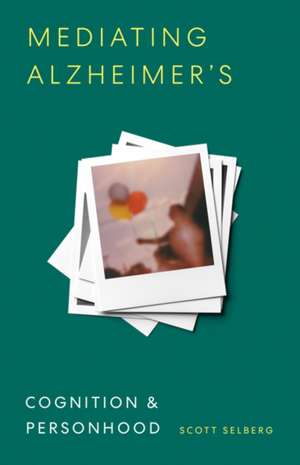Mediating Alzheimer's: Cognition and Personhood
Autor Scott Selbergen Limba Engleză Hardback – 24 mai 2022
An exploration of the representational culture of Alzheimer’s disease and how media technologies shape our ideas of cognition and aging
With no known cause or cure despite a century of research, Alzheimer’s disease is a true medical mystery. In Mediating Alzheimer’s, Scott Selberg examines the nature of this enduring national health crisis by looking at the disease’s relationship to media and representation. He shows how collective investments in different kinds of media have historically shaped how we understand, treat, and live with this disease.
Selberg demonstrates how the cognitive abilities that Alzheimer’s threatens—memory, for example—are integrated into the operations of representational technologies, from Polaroid photographs to Post-its to digital artificial intelligence. Focusing on a wide variety of media technologies, such as neuroimaging, art therapy, virtual reality, and social media, he shows how these cognitively oriented media ultimately help define personhood for people with Alzheimer’s. Media have changed the practices of successful aging in the United States, and Selberg takes us deep into how technologies like digital brain-training and online care networks shape ideas of cognition and healthy aging.
Packed with startlingly fresh insights, Mediating Alzheimer’s contributes to debates around bioethics, the labor of caregiving, and a national economy increasingly invested in communication and digital media. Probing the very technologies that promise to save and understand our brains, it gives us new ways of understanding Alzheimer’s disease and aging in America.
With no known cause or cure despite a century of research, Alzheimer’s disease is a true medical mystery. In Mediating Alzheimer’s, Scott Selberg examines the nature of this enduring national health crisis by looking at the disease’s relationship to media and representation. He shows how collective investments in different kinds of media have historically shaped how we understand, treat, and live with this disease.
Selberg demonstrates how the cognitive abilities that Alzheimer’s threatens—memory, for example—are integrated into the operations of representational technologies, from Polaroid photographs to Post-its to digital artificial intelligence. Focusing on a wide variety of media technologies, such as neuroimaging, art therapy, virtual reality, and social media, he shows how these cognitively oriented media ultimately help define personhood for people with Alzheimer’s. Media have changed the practices of successful aging in the United States, and Selberg takes us deep into how technologies like digital brain-training and online care networks shape ideas of cognition and healthy aging.
Packed with startlingly fresh insights, Mediating Alzheimer’s contributes to debates around bioethics, the labor of caregiving, and a national economy increasingly invested in communication and digital media. Probing the very technologies that promise to save and understand our brains, it gives us new ways of understanding Alzheimer’s disease and aging in America.
Preț: 738.90 lei
Preț vechi: 810.80 lei
-9% Nou
Puncte Express: 1108
Preț estimativ în valută:
141.45€ • 145.48$ • 117.35£
141.45€ • 145.48$ • 117.35£
Carte indisponibilă temporar
Doresc să fiu notificat când acest titlu va fi disponibil:
Se trimite...
Preluare comenzi: 021 569.72.76
Specificații
ISBN-13: 9781517902285
ISBN-10: 1517902282
Pagini: 352
Ilustrații: 15 b&w illustrations
Dimensiuni: 140 x 216 x 25 mm
Greutate: 0.51 kg
Editura: University of Minnesota Press
Colecția Univ Of Minnesota Press
ISBN-10: 1517902282
Pagini: 352
Ilustrații: 15 b&w illustrations
Dimensiuni: 140 x 216 x 25 mm
Greutate: 0.51 kg
Editura: University of Minnesota Press
Colecția Univ Of Minnesota Press
Notă biografică
Scott Selberg is a member of the faculty of the Department of Communication at Portland State University.
Cuprins
Introduction: Alzheimer’s and Media
1. Origin Myths: History, Histology, and Representational Value
2. New Media Pioneers: Neuroimaging a National Crisis
3. Use It or Lose It: Affirming the Self, Defining the Person
4. PET Scans and Polaroids: Anachronizing Personhood
5. Dementia in the Museum: Modern Art as Public Care
6. Dementia on the Canvas: Art, Therapy, and Creativity’s Values
7. Loved Ones: The Capacity for Representation, Recognition, and Care
Epilogue: “How to Not Forget”
Acknowledgments
Notes
Bibliography
Index
1. Origin Myths: History, Histology, and Representational Value
2. New Media Pioneers: Neuroimaging a National Crisis
3. Use It or Lose It: Affirming the Self, Defining the Person
4. PET Scans and Polaroids: Anachronizing Personhood
5. Dementia in the Museum: Modern Art as Public Care
6. Dementia on the Canvas: Art, Therapy, and Creativity’s Values
7. Loved Ones: The Capacity for Representation, Recognition, and Care
Epilogue: “How to Not Forget”
Acknowledgments
Notes
Bibliography
Index
